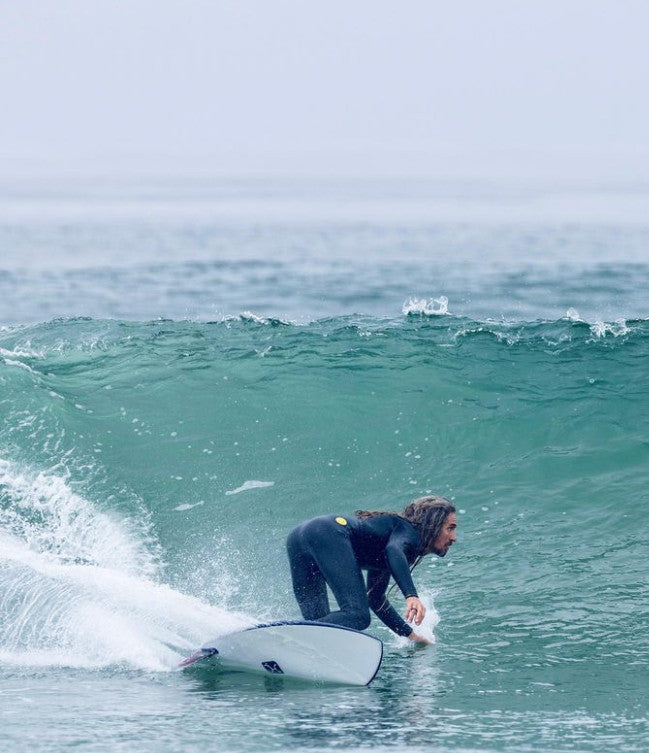Surf Maneuvers Series PART 2: Pumping Down the Line
Share
Pumping Down the Line - How to Generate Speed
Surf Maneuvers Series by Hawaiian South Shore:
- Surf Maneuvers Series Tip 1: Taking Off on a Shortboard
- Surf Maneuvers Series Tip 3: Bottom Turn/Top Turn Combo
- Surf Maneuvers Series Tip 4: Floaters and Foam Climbs
- Surf Maneuvers Series Tip 5: Roundhouse Cutback
- Surf Maneuvers Series Tip 6: The Down Carve
- Surf Maneuvers Series Tip 7: Layback Snap
For every maneuver that is performed on a shortboard, the more speed you have, the better. Not only does momentum help you get down the line and through long, fast sections, but speed also enables you to turn more aggressively and flow through maneuvers with more style and fluidity. This is why learning to pump properly—and thereby generate your own speed, rather than depending on the wave to provide it—is one of the first maneuvers that should be learned.
To fully understand the mechanism of an efficient pump, it is a good idea to watch a few videos of professional surfers. You will notice almost immediately that their pumps involve a lot of flow and very little jerky movements.
Compare this to the average surfer you see out at your local spot—especially those who are relatively new to surfing—and you will quickly see the difference. Many beginner and intermediate surfers think they are pumping, when actually what they are doing is a lot closer to hopping. They tend to hop off of their back foot, bouncing down the line in a choppy manner that actually impedes their progress rather than creating speed. Every time the board is hopped, it breaks the planing surface and interferes with momentum—so even though it might feel like you are generating speed, the reality is you are simply starting and stopping a bunch of times.

A good pump will be smooth and fluid, rather than choppy and bouncy. It involves using the rail of the board to climb and descend the face of the wave, tapping into the natural to generate speed without any jerky movements that interfere with your trajectory down the line. As you climb the wave face, you are allowing your board to be drawn upward with the curl, which generates speed. Then, as you descend the face, you are using gravity to generate even more speed. When done correctly, this up-and-down rail surfing on the face enables you to generate more speed than would normally be provided by just standing on your board in a trim position.
To better understand this motion, it is useful to refer to a term that was popularized during the Shortboard Revolution of the 1960s and 1970s, when performance surfing began to evolve. Many people during this time spoke about “rock-and-rolling” as if it were a maneuver, and the name sort of serves as an intuitive description for what you are doing. As surfing evolved—and as your surfing progresses—rock-and-rolling was pushed further and further until it became bottom turn/top turn combinations. And although it may seem counterintuitive, today’s top pros actually gain speed through these more aggressive bottom turn/top turn combinations, effectively using their maneuvers as speed pumps. That’s why you will often see pros flying down the line at speeds that seem nearly impossible, even though they don’t seem to be visibly pumping between maneuvers.

For those of us mere mortals who want to improve our surfing, it is usually necessary to differentiate between speed pumps and what we consider to be actual maneuvers, but if you shift your mentality a bit and begin to think of pumps as mini-maneuvers, it can help you tap into a more efficient down-the-line motion.
Most people find it easier to pump frontside, as you are facing the wave and riding on your toe rail, which affords you more control. Heel side (or backside) pumping is a bit more difficult since you are facing away from the wave and riding on your heel rail (the heels being much less sensitive and flexible than the toes). The trick here is to square your shoulders with the rails of the board so that your upper body (and particularly your head) is projecting down the line toward the shoulder of the wave. It is important to remember that your board will go wherever your body guides it, and your body will go wherever the head leads—so when pumping (and when performing pretty much every other maneuver in surfing), it is vital to lead with your head. Once you are looking down the line, with your upper body turned toward the shoulder and projecting toward the channel rather than toward shore, use your hips to bring the board slightly up the face and then back down toward the trough.
Again, spend some time watching videos of pros pumping backside and you will notice two things. First of all, although they are technically surfing on their heel side, their backs aren’t really facing the wave. Instead, their upper bodies are pivoting on their waist so that they are projecting down the line. And second, their hips and knees are doing all of the work throughout the pump.
As with most maneuvers in surfing, an academic description of the process can only get you so far. Ultimately, you will need to put in a lot of hours practicing pumping before you master it.
The most important thing is to avoid developing bad habits while doing so—because whatever you repeat thousands of times will eventually become ingrained in your mind and in your surfing. Start out slow, focus on being smooth, and take note if you ever find yourself hopping. One long, drawn-out pump on the rail is much more effective than five short, choppy pumps—and it will ultimately reinforce positive, efficient movements that will one day evolve into a fast, dynamic pump through the section.
